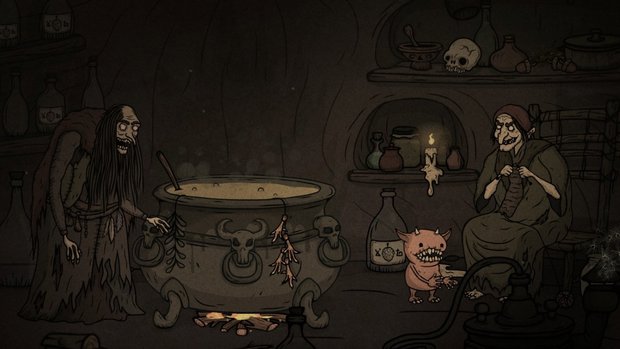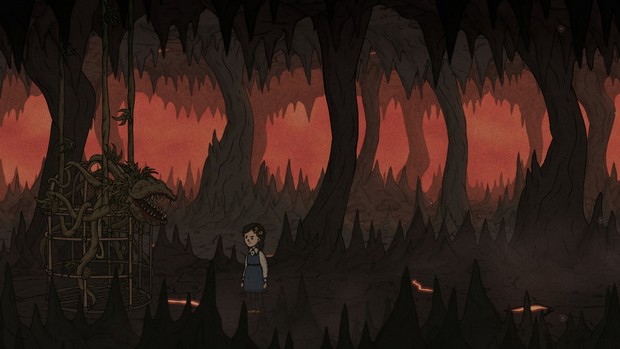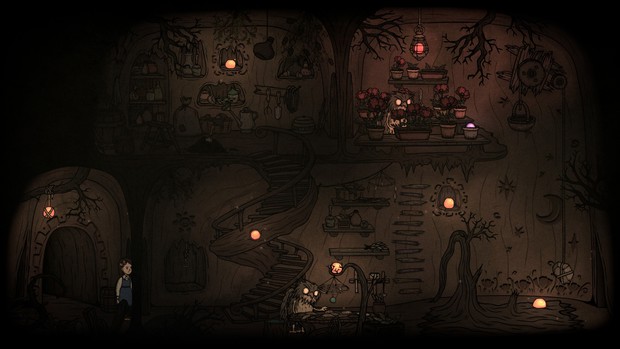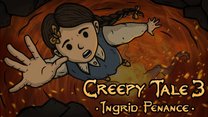Creepy Tale 3: Ingrid Penance review

- 0 Comments
Minor sins of atmospheric sequel more than atoned for by its virtues
First off, yes, you’re right—it absolutely should be called Ingrid’s Penance. If you’d seen the game advertised and extended it some benefit of the doubt that its youthful heroine might be the daughter of a Mr. and Mrs. Penance, go ahead and withdraw it. There is definitely, empirically, undeniably, a big old honking typo right there for all to see in the title of Creepy Tale 3, and as first impressions go it’s about as auspicious as a wedding band on a first date. And that’s a real shame, because once the opening titles fade and the game gets underway, this is actually a rather solid little horror adventure. Coming on the heels of two promising but flawed entries—an intriguing but overly derivative debut and a more assured follow-up that introduced a host of new problems—Creepy Tale 3 often feels like the spooky, atmospheric fantasy its predecessors tried to be. Is it perfect? Well, clearly not, but its faults are easier to accept when it achieves so many of its aims with aplomb and macabre personality. For the first time in three years, I’m cautiously optimistic to see what the Creepy Brothers might do next.
Creepy Tale 3 takes its setup from “The Girl Who Trod on the Loaf” by Hans Christian Andersen, in which a vain, spoiled child carrying a loaf of bread to her family is dragged to Hell after using it to step across a mud puddle. (Another life-affirming yarn from the author of “The Little Match Girl,” everybody!) The game grabs that concept and runs with it, as the child (named Ingrid, obviously) awakens in the infernal realms and, convinced she doesn’t belong there, sets about trying to escape. Naturally that’s easier said than done—say one thing for Hell, they don’t cheap out on security—but Ingrid finds what could be a lifeline in the form of a young imp called Molek. (That’s not his name, per se; as he explains, all imps are called Molek.)
Molek tells Ingrid that she might be able to escape by playing “a funny game.” The rules are simple: wander through Hell and “just be yourself.” Eventually she’ll reach a portal to the land of the living and, based on her actions along the way, she may be judged worthy to return. To this end she’s granted a particular gift: a number burned into the palm of each hand, with the left representing her sins and the right her good deeds. Either of these numbers can increase based on her behavior, and depending on her final count, the portal may just open to let her through—though Molek declines to specify the exact numbers she’ll need. Fail to make it through, however, and she’ll remain in Hell as a frozen statue.

As Ingrid, the player embarks on a whirlwind journey through a series of bizarre, spooky and downright unsettling set pieces. These include the bowels of a vast flesh-beast, where a legion of laboring Moleks toil to keep it fed from within; a fortress full of owls who steal children’s dreams; and, most memorably, the domain of Auntie Toothache, the most diabolical of Hell’s (presumably many) dentists. While the specifics change in each scenario, Ingrid’s goal remains the same: get away from anything detaining her and keep moving toward the portal. She’ll also have to avoid a plethora of monsters who’d like nothing more than to tear her apart. You can die in Ingrid Penance, and often quite graphically, but as she’s already in the afterlife Ingrid will simply rematerialize at the beginning of the sequence that did her in. (Usually she’ll keep anything she picked up before meeting her most recent end, but one death forced me to redo all the steps of the large and involved puzzle I’d nearly finished beforehand.)
There are often multiple ways to solve a puzzle, which gives you room to think creatively; still, seasoned adventurers should consider carefully before acting. We’re used to games forgiving any amount of theft, deceit or borderline sociopathy that gets their protagonists where they need to be; in Ingrid’s case, however, the more quick-and-dirty solution isn’t necessarily the best one. Any selfish or callous behavior risks increasing your sin counter, and as there’s no way to know the point of no return, it pays to evaluate your options. (There are three possible endings, each corresponding to a different numerical range of sins and virtues; depending on how you play Ingrid and what you think of her character, any of the three might feel like the “best” one.) It’s usually obvious whether an action is good or bad before you’ve gone through with it, though the weighting seems a bit off—regardless of magnitude, a sin or virtue is only ever worth one additional point on your counter, meaning a rude retort is exactly as sinful as improvised, non-consensual surgery.
Puzzles are many and diverse, based variously around logic, inventory use, and spatial reasoning. Several involve figuring out how to operate machinery or bypass unusual locks, and these are well-clued and satisfying to work out. There was one sequence where I found myself truly stuck and frustrated—a close-up object-manipulation sequence where I had to assemble a dreamcatcher—until I eventually realized that a required component had been placed on the screen in such a way that it seemed like a background element.

The most inspired sequence comes when Ingrid enlists the help of an aged ghoul to break into Auntie Toothache’s towering mansion. She’s too small to make the climb by herself, and he’s too big and clumsy, so they’ll have to combine their strengths to make a path for themselves. At this point you’ll be able to switch back and forth between them, alternately using Ingrid’s speed and maneuverability and the ghoul’s strength and stature to climb higher and bypass the obstacles keeping you from the top. These are smaller puzzles dotting the mansion’s facade, with each requiring you to think carefully about which character should be where, what one can do that the other can’t, and how they might act in concert to progress. It’s a long, multistep process featuring a creative variety of puzzle types, and reaching the top feels like a real achievement.
While the interface and controls are simple—the arrow keys or joystick move Ingrid, with dedicated buttons for opening your inventory, interacting with hotspots, swapping characters, and checking your sin/virtue count—they don’t always work as intended. Ordinarily moving Ingrid near a hotspot calls up a context-sensitive icon, letting you know both that there’s something there and what you can do with it. A few key sequences, though, require you to collect a number of small, easily missed objects for which, inexplicably, the icons never materialize. The game doesn’t tell you what you’re looking for—you just know you must be missing something—and so I wandered around in circles looking for some sign of what I needed, only saving myself with a desperate and blindly optimistic button press. If this is a design choice and not a glitch—and I’m genuinely not sure—it’s a cheap and unfair one, creating an artificial “puzzle” by secretly changing the rules.
There are also dialogue quirks that muddle and overcomplicate some puzzles. Ingrid won’t do something until she has a good reason—i.e., if you don’t need an item yet, she won’t pick it up—but the game often fails to distinguish between a flat-out refusal (“I don’t need this”) and a conditional one (“Why would I need this right now?”). This means you can get stuck on a puzzle only to realize later that the solution was something you’d already tried. In a similar vein, one item collection puzzle requires getting a part from a particular character, who’ll give it to you with the proviso that he doesn’t have any more after that; if you ask again, he’ll repeat himself. The eventual solution, for which there are no clues, is that you had to keep asking a few more times anyway.

As with previous entries, Creepy Tale 3 owes more than a passing debt to the horror art of John Kenn Mortensen. The first game’s biggest failing was in how directly it imitated his work and design ethos, with many of its visuals coming off like blatant reproduction; an “Inspired by the Work of” credit at the finale seemed less a professional courtesy and more a fig-leaf against a potential lawsuit. Creepy Tale 2, for all its other faults, wisely abandoned this approach in favor of a rounder, more cartoonish aesthetic that merely took some cues from Mortensen’s philosophy. I was curious to see which direction the developers would take with Ingrid Penance; it turns out the answer is … complicated.
The good news is that while Mortensen’s influence on Ingrid Penance is obvious—more so than in the second game—it doesn’t feel like his actual work is being appropriated. Creepy Tale 2’s unique visual DNA is still present in the backgrounds, albeit with a leaner, more ominous character than that game’s fairy-tale setting; the line work seems more confident here, with an assurance that speaks to a clearer vision of what Creepy Tale ought to be. Many of the characters likewise sport impressively original designs that, despite clear stylistic influences, don’t come across as overly derivative; an obese, multi-armed merchant and the shaggy, menacing owls are particular standouts.
That said, there are places where the developers seem afraid to step too far out of Mortensen’s shadow. Some monster designs feel like they came about not from considering what fit the character but from asking “What would John Kenn Mortensen put here?” The result is that several prominent encounters meant to shock and horrify look like they’ve been assembled from a kit instead. You won’t have seen Auntie Toothache herself before, but if you know Mortensen’s work (or you’ve played the original Creepy Tale) then you’ll recognize her basic affect: the toothy mouth; the wild, hollow eyes; the emaciated, long-limbed frame. Much of the game’s other design work shows that the developers were more than capable of taking the concept of “Hell’s dentist” and running with it in some unexpected direction; they opted instead for a familiar-looking wicked witch who just happens to wear a white coat. Mortensen’s own career has spanned decades, over which he’s continually found new ways to surprise and terrify his audience; these designs, on the other hand, feel like obvious and almost generic choices, putting discount monster costumes tailored after someone else’s sensibilities onto characters that deserved distinct identities.
It’s especially disappointing in a game that’s otherwise put together so well, and whose other elements add up to something that feels like nothing so much as itself. The score is enchanting, each screen boasting its own unique synth-orchestral theme organized around a unifying motif for the larger location. The voice cast is excellent, with the Slavic-accented actors committing fully to their roles and vaulting over any pronunciation or delivery issues through the force of sheer charisma. Eva Finkelstein is an especial standout as Ingrid, bestowing a multifaceted and sometimes even charming personality upon a character who could easily have seemed a one-dimensional brat.
Final Verdict
With each entry in their series, I’ve felt like the Creepy Brothers had it in them to make something truly special. Creepy Tale 3: Ingrid Penance isn’t quite that game; there are still niggling problems with some of its moving parts, and the developers’ apparent ambition to work within boundaries set by another artist keeps their strange world from feeling truly unique. Still, they’ve come closer here to fulfilling that promise than they ever have before, with solid puzzles, a creative yet straightforward story, and a presentation that works hard to create a weird, scary atmosphere where anything can happen.
Hot take
While a few questionable design choices and derivative character art keep it from achieving true greatness, Creepy Tale 3: Ingrid Penance is nonetheless a solidly eerie, atmospheric and challenging adventure.
Pros
- Interesting story and characters with an excellent voice cast
- Challenging, well-designed puzzles
- Versatile soundtrack creates a wonderfully macabre atmosphere
- Some memorable monster designs along with impressive background art
Cons
- Visual style obviously inspired by the work of John Kenn Mortensen sometimes hews too closely to his example to feel truly original
- A handful of poorly clued puzzles
- Sin/virtue system could have used a bit more nuance
Will played Creepy Tale 3: Ingrid Penance on PC using a review code provided by the game's publisher.










0 Comments
Want to join the discussion? Leave a comment as guest, sign in or register.
Leave a comment